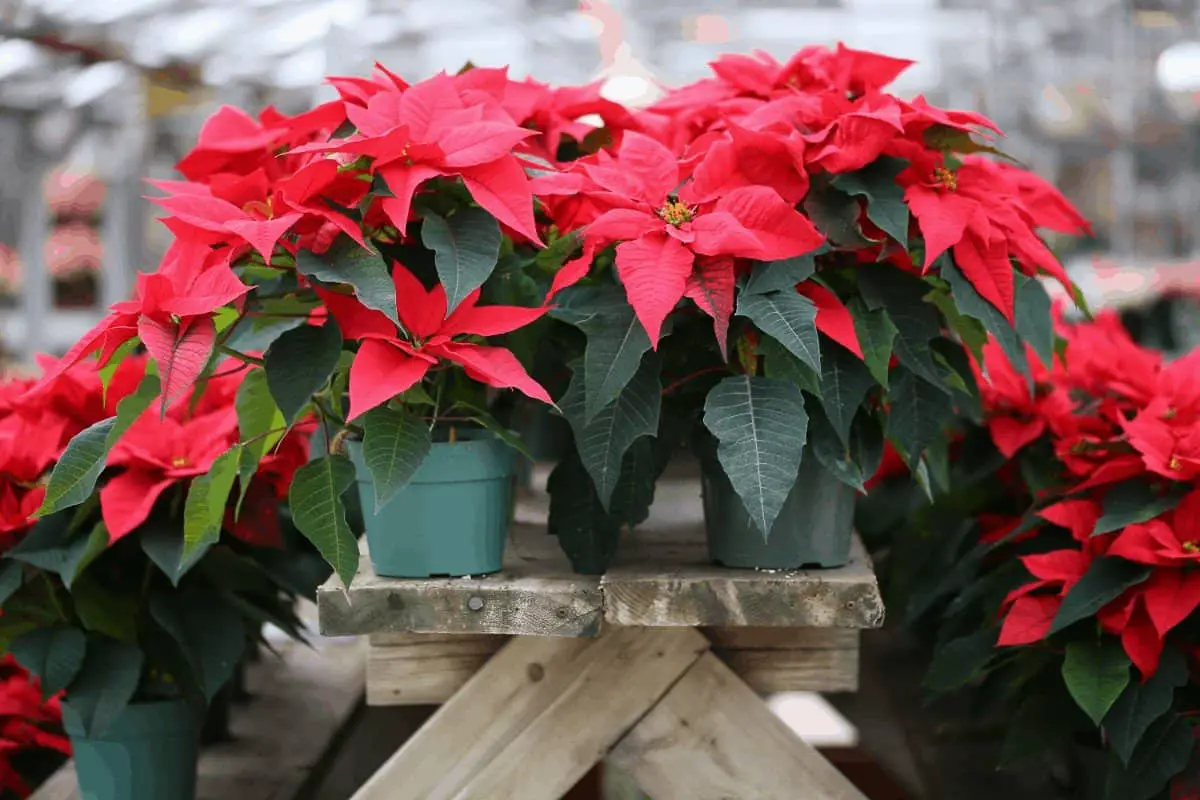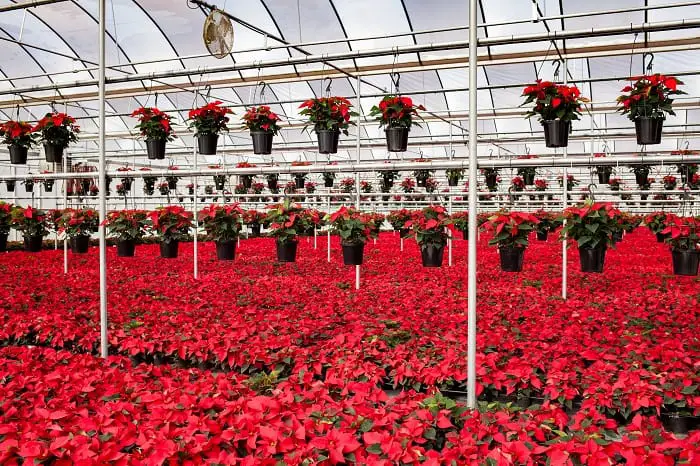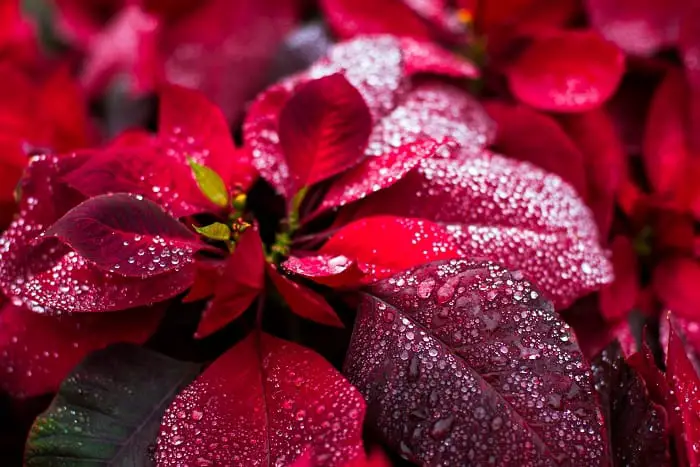Last Updated on February 24, 2023 by Sharon Vanessa
The Poinsettia, native to Mexico is a fine plant with colorful foliage of red and green. Since it bears the bright colors of Christmas, it’s also known as “Christmas Flower”. The poinsettia is a commercially viable plant and derives its name from the first minister of the United States to Mexico, Robert Poinsettia. The plant is easy to maintain and a favorite plant for interior gardening. However, the poinsettia is sensitive to the climate. It has some reservations when it comes to winter’s chilling breeze and too much exposure to it in such extreme weather conditions can be detrimental to the plant. In order to keep this plant in good shape, you need to be aware of the suitable temperature for it, else you’ll watch the plant become a shadow of its previous self which is typically luxurious, greenish and colorful. The boiling question that serves as the base for the article is, are poinsettias cold hardy.
Can I Put a Potted Poinsettia Outside?
Can I put a potted poinsettia outside? Yes, you can put a potted poinsettia outside during the warmer months. Be sure to harden it off gradually to prevent sunburn or shocking the plant, and move them back in before the temps drop below 60°F.For an interesting, unusual outdoor plant, poinsettias can be taken outside in the spring when the danger of a freeze is past. Place the plant in a shady location, and it can be enjoyed throughout the summer. To keep the plant small and compact, cut it back about mid-July and early September to stimulate branching.A spot on a patio or covered area will be perfect, as long as there is no afternoon sun. Try to keep them out of droughts and cold winds. In nature Poinsettias flower during the winter, here in South-Africa the growers actually decrease the amount of light to promote flowering.
How Long Do Poinsettias Live?
How long can you keep a Poinsettia alive? That depends on how well you follow the tips above, but on average a well-cared for poinsettia should last about 4-6 weeks until the flowers start to fall off and you can keep the plant healthy and alive for many months after the holidays come to an end.Poinsettias need not disappear after the holiday season. These plants can be kept alive and healthy year round with just a bit of special care. If you want to go the extra mile, you can take a few extra steps to ensure your plant flowers again in time for the next Christmas.
After all the leaves have fallen, store the plant, in its pot, in a cool (50 to 60°F), dry, dark area. Keep the plant somewhat on the dry side; water only enough to keep the stems from withering.However, with a little care and attention it’s possible to keep your poinsettia alive throughout the year and even encourage red bracts and flowers to form in time for the following Christmas.
Poinsettias are native to Mexico and live in the wild in Central America. They are a popular Christmas house plant in North America, and rarely outlive other Christmas decorations. But Allison’s plant has survived 26 years.
Poinsettia Care by Month?
Poinsettia, also known as the Christmas plant, remains one of the most popular holiday flowers. With the introduction of long-lasting cultivars, the popularity of the poinsettia has increased significantly. It was introduced to the United States in 1825 by Joel Robert Poinsett, first U. S. ambassador to Mexico who obtained plants from the wilds of southern Mexico.
Late Winter and Early Spring Care
January – April: Keep watering the poinsettia whenever the surface is dry. Fertilize as needed every 2 weeks with an all-purpose houseplant fertilizer at recommended rates. During this time, side shoots will develop below the bracts and grow up above the old flowering stems. In early March in order to have a well-shaped plant for the following year, you need to cut each of the old flowering stems or branches back to 4 to 6 inches in height. Leave one to three leaves on each of the old stems or branches. New growth will come from the buds located in the leaf axils. Cutting the plant back will cause the buds to grow and develop. Keep the plant in a sunny window at a temperature between 60 and 70 degrees fahrenheit. Check your plant for signs of insects such as whitefly. If present, use Sticky Whitefly Traps and/or Insecticidal Soap. Remove faded and dried parts of the plant. Add more soil, preferably a commercially available sterile soil mix. Starting April 1st, gradually decrease water, allowing the plant to get dry between waterings. Be careful the stem does not begin to shrivel. This is a sign the plant is too stressed and is dying. In a week or two, when the plant has acclimated to this drying process, move it to a cool spot like the basement or a heated garage. You want to keep it at about 60 degrees fahrenheit.
Late Spring and Summer Care
May: Cut back stems to 4–6 inches above the soil. Repot in a slightly larger container, with new potting soil using Pesche’s Potting & Planting Mix. Water well. Place the newly potted plant back into the brightest window you have and once again keep it at a temperature of 65 – 75 degrees fahrenheit. Continue watering whenever the surface of the soil feels dry.
Watch for new growth. Once new growth appears, begin fertilizing every two weeks with a complete fertilizer.
June: After the danger of spring frost is past and night temperatures exceed 50 degrees fahrenheit, move the plant outdoors in a slightly shaded spot. Remember that the plant may need to be watered more frequently than the rest of your garden. Fertilize more frequently as plant grows. Trim off two to three inches of branches to promote side branching.
July: Pinch back each stem by about one inch. This is to encourage a stout, well branched plant. If left unpinched, the poinsettia will grow tall and spindly. Move it into full sun. Continue to water and fertilize but increase the amount to accelerate growth.
August 15: The stems should have branched and leafed out. Once again, pinch or cut the new stems, leaving 3-4 leaves on each shoot. Continue watering and fertilizing.
Fall Care and Re-blooming Phase
To re-flower your poinsettia, you must keep the plant in complete darkness between 5pm and 8am daily from the end of September until color shows in the bracts (early to mid-December). The temperature should remain between 60 and 70 degrees F. Night temperatures above 70 to 75 degrees fahrenheit may delay or prevent flowering. If you follow this procedure the poinsettia will flower for Christmas.
September: Bring the poinsettia indoors to a sunny location that gets at least six hours of direct light daily, preferably more where the temperature is 65 to 75°F. Continue watering and reduce the amount of fertilizer. Don’t prune your plant later than September 1st. Starting on or near September 21st (Autumnal Equinox) for about 10 weeks, give the plant 13 hours of uninterrupted darkness (put the plant in a closet, basement, or under a box) and 11 hours of bright light each day. Maintain night temperatures in the low 60 degree °F range. Continue to water and fertilize. Rotate the plant daily to give all sides even light.
October 1: Poinsettias are short-day plants, for a mid-December bloom date, your poinsettia needs complete darkness for 15 continuous hours each night (5pm to 8am). You can either move your plant into a dark room, or cover it in a large opaque box. Any exposure to stray light of any kind could delay the flowering process. Many people place their plants in a closest, but if light gets in through the cracks or if you open and use the closet, it will affect the bud set. During this time, it is also crucial that your plant gets 7 to 9 hours (from 8am to 5 pm) of bright sunlight daily, so when bringing your plant out of the darkness, choose a sunny spot for it to live. Water as needed and fertilize weekly until bract color develops.
November:
Once color is visible, around the last week of November (Thanksgiving), discontinue the short day/long night treatment. Put the plant in a sunny area that gets at least six hours of direct light. Reduce water and fertilizer. You should see flower buds at this point
December:
Stop fertilizing about December 15th. Keep watering and treat your plant the way you did when you first brought it home in bloom. If all has gone well, it should be back in bloom and ready to begin the process all over again.
CHRISTMAS–Enjoy your “new” poinsettia. Start the cycle all over again.
How Do You Get a Poinsettia to Rebloom?
To re-flower your poinsettia, you must keep the plant in complete darkness between 5pm and 8am daily from the end of September until color shows in the bracts (early to mid-December). The temperature should remain between 60 and 70 degrees F.t’s probably getting too much light in your office. Put the poinsettia in a closet or cover it with a box for 13 to 16 hours each night, according to plant experts from the Lowe’s chain of home improvement stores. In the morning, put the plant in a place where it can receive eight hours of indirect sunlight.///////////
Can Poinsettias Be Left Out in the Cold?
Well, the plant is allergic to winter and the straight answer is No.
Let’s delve into more about the plant and why the answer is on the negative side here.
The Poinsettia in its indigenous habitat can attain a height of about 10 feet with a dense bush tagging along with that imposing height. It’s typically an indoor plant and is usually sold in containers. When it starts to flourish and its spectacular leaves begin to leave their host plant, you are permitted to take it outdoors but beware of the chilling winds.
Their growth pattern in their native habitat is a little more rapid compared to any other location they may find themselves. This accelerated growth pattern causes the bulk of their colorful bracts to fall off, especially the red foliages leaving you with a thick green bush.
When you decide to move the plant outdoors, be wary of certain low temperatures. Any temperature below 50 degrees Fahrenheit is potentially fatal for the plant. At this temperature, the cold hardiness of the plant has gone beyond the tolerance level, this will then compel the leaves to fall off.
If this climatic condition endures much longer, the leaves won’t be the only problem a poinsettia owner be worried about but the entire plant. Such sustained temperatures at 50 degrees Fahrenheit will cause the entire root system of the plant to wither away and since the root system is the cornerstone of the plant, the entire plant becomes history.
This is why the poinsettia plant can’t be left out in the cold. It should only be grown indoors and brought out when it’s summertime. When you see the signs of winter, just know its time to rush it indoors if you want to salvage the glory of the plant.
What’s Next After the Plant is Indoors?
Now the plant is indoors, no thanks to winter who says she can’t stay out in the cold, that’s not all. You need to place the plant in a shaded or dark portion of your indoor space from 5:00 pm to 8:00 am within October and November. The reason is that poinsettias need an average of 14-16 dark hours for up to a minimum of 10 weeks if they need to bloom in flowers. They need the dark for flowering and you have to grant them that satisfaction.
You can also expose the plant to some ample sunlight when the sun rises or place it close to the window where the rays of sunlight can reach it indoors. You need to water it when you notice that the resident soil is getting drier. If you keep up with healthy practices like this, you would have no problems with the poinsettia plant, rather you stand to enjoy all of its colorful splendor and the beauty of indoor gardening.
On Fertilizing the Plant
It’s also ideal during this period (when the plant is indoors) to fertilize the plant, even outdoor plants with all of nature’s blessing still need fertilization to thrive, the poinsettia has been deprived of those natural perks and needs a little fertilization to match up. Fertilize the plant every two weeks when you take it out in summer using a liquid fertilizer. If you live in an area where the weather is full of surprises, then you need to provide an organic mulch for the root system, since the weather can pretty much surprise itself by extremely cold one summer night. However, you need to stop fertilizing when the plant begins to display its colorful bracts.
Some Other Things to Note
In order to keep tabs with the seasons and be conscious of when the first frost arrives so, you can hurry your dear plant indoors, you need to check with your local extension office. Checking with this office affords you the information on when the last frost left and when the new one is coming. This will then help you determine when it’s time to send your plant indoors.
As a thumb rule with the seasons and plants, you need to also wait till the normal temperature is around 70 degrees Fahrenheit during the day and not falling below 50 F during the night. You need to also watch out for weather reports about the climate in your area. Most times in summer when the plant is outdoor, weather reports might surprisingly indicate that it will get colder on a certain night, this means your plant will be spending the night with you instead of outdoors, for its own good.
Conclusion
The poinsettia plant is one that is sensitive to times and seasons. So weather because an integral factor when it comes to growing it. Indoors during winter and outdoors during summer while keeping up with the maintenance processes like pruning, watering, exposure to sunlight and fertilization are some of the things you need to have at the tips of your finger when growing this plant if you want to have a healthy poinsettia that will give you the thrill of indoor flowering all year round.
amzn_assoc_placement = “adunit0”;
amzn_assoc_tracking_id = “gardeningdreams-20”;
amzn_assoc_ad_mode = “manual”;
amzn_assoc_ad_type = “smart”;
amzn_assoc_marketplace = “amazon”;
amzn_assoc_region = “US”;
amzn_assoc_linkid = “90057433cca207eb1884a653ff39bd99”;
amzn_assoc_design = “in_content”;
amzn_assoc_asins = “B00ZUQBQDE,B07QNMBLGQ”;
Tony Manhart is a passionate gardener who has been tending to gardens for over 20 years. He takes pride in creating beautiful outdoor spaces with plants, trees, and shrubs that can thrive in any environment. He loves to share his knowledge with others and has taught classes on gardening basics and advanced techniques. He is committed to sustainability, using natural and organic methods to create and maintain gardens. He also works with local organizations to create green spaces for communities. When he’s not gardening, Tony enjoys hiking, reading, and spending time with his family.



